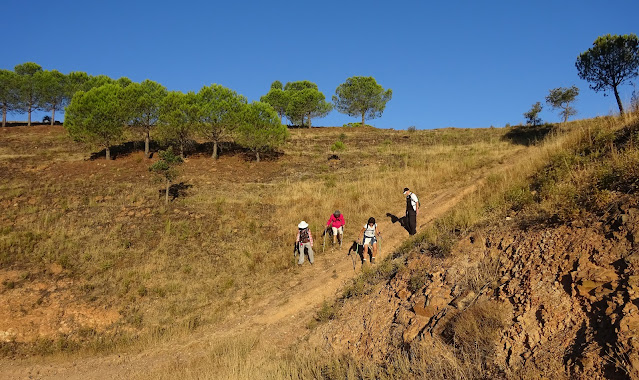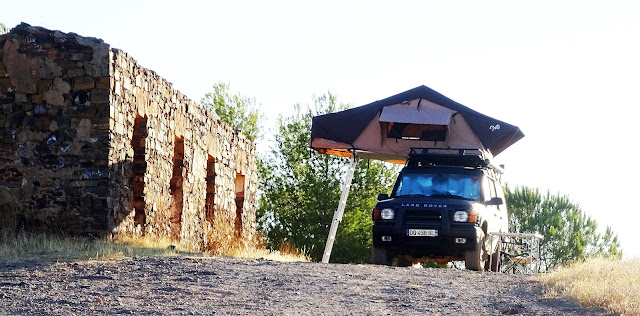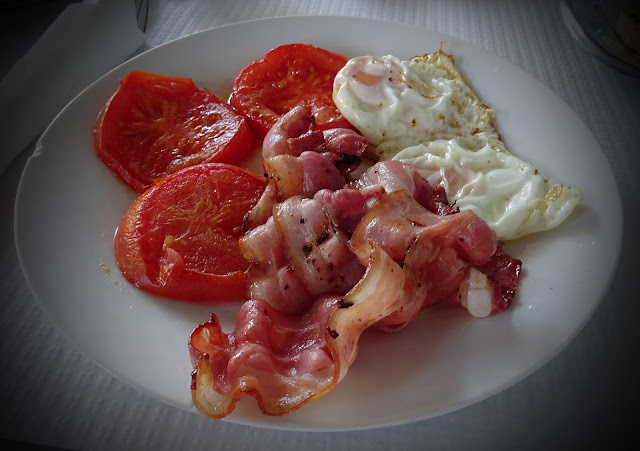This week´s walk got off to a rather slow start, for various reasons. Myriam had arrived first but then had disappeared into the boondocks and didn´t reappear for some time And Our professional photographer had paused enroute to photograph storks and (I think) the Silves Roman Bridge in the sunrise and turned up a bit late. Etc etc.
( I am not sure if this is the correct one -this looks like a sunset but no doubt Yves will clarify. Never mind, it´s an excellent picture).
So there we are, despite a scheduled start of 07.00, the Leader is looking at his watch at 07.04 wondering when we can get round to doing the Starter Photo, if ever.
 |
| 07.04 |
But then Maria needed to chat with Hazel on WhatsApp but could not locate her on her mobile, and this required the convening of a sub-committee meeting to try to solve the problem.
 |
| 7.10 |
 |
| 7.12 |
Sub-committees etc, etc,over, the Starter Photo is taken, at 07.15.
 |
| 07.15 |
Then Myriam finds that she has forgotten her hat and has to retrieve it from her car.
 |
| 07.18 |
The Leader graciously offers to retake the Starter Photo complete with retrieved hat but his offer is equally graciously declined. We probably eventually set off at about 7.20. After all that excitement, not much really happened during the walk worth reporting.
Terry
and Yves walked well ahead of the rest of us most of the time and
were very patient waiting for us to catch up. We all did it in 1 hour 45 minutes moving time. They two could probably do it in 1 hour flat.
Then, the Leader, in trying to introduce new tracks for variety´s sake, made a mistake as a result of which we found ourselves facing a choice of either climbing a very steep upward slope or of negotiating a tricky and steep downward gully, off-piste. We chose the gully. Nobody fell, luckily.
 |
| Trickier than it looks |
Nevertheless, the early morning sunlight was pleasing to the eye.
Must be a delicate balancing act if one of them needs to get up in the middle of the night.
We passed the area where the Camara had being doing a lot of tree planting and it was good to see the successful results. Not all the new saplings have been eaten by deer.Later on, we came across a couple of men collecting alfarroba (carob) pods and Yves and Myriam engaged them in conversation.
They said that they were harvesting the pods with the permission of the landowners, a rich Silves family (Maria knows the details). Probably so. There have been several reports recently of people being arrested for stealing carobs, but these two guys would been daft to be so open about it if they had not got permission, nor would they have been happy for us to take their pictures.
Among other news reports, Observador reported recently that the GNR had seized 15 tons (15000 kilos) worth Euros 28,000 from one presumed thief, and said that the price has increased tenfold in recent years.
The unit of measurement for alfarroba is the arroba, a weight measure used in Portugal and Spain as well as in Latin American countries (and also in Macao.) The weight of an arroba varies between 10.00 kilos (Uruguay for example), 11.5 kilos (Venezuela and Spain), and 15.00 kilos (Portugal and Brazil). (By the way, a Macanese arroba weighs in at 14.688 kilos - I wonder why it differs from the Portuguese measure.)
As to the rise in price, apparently four years ago the market price of carob in the Algarve was 5 euros per arroba and now it is between 40 and 50 euros. No wonder thefts are increasing. Difficult to fence in and guard carob tree areas. But we have also recently seen carob tree areas being destroyed to allow for more avocado planting. Good move or bad move?
A little further on, Yves was seen attacking a tree trunk with a large piece of stone. Such was the vigour of his blows that it was the stone, not the tree, that broke.
We did not stop to ask him why he was doing that. But later it could be deduced that he was smoothing a surface for his model to pose on.
The Track and the Statistics (as many as one could wish for )
But the breakfast was good as ever. Para e Fica must be in the running for the “Best Bacon of the Year” award”
 |
| I don´t know why Myriam´s hand is trying to grab my breakfast She didn´t mean to. Extra bacon for the men |
 |
| "Enjoy your breakfast.... or else" |
Some serious eating and light hearted conversation. Attempts were made to contact Paul, to no avail. Probably difficult to carry a mobile when one is on a nude beach.
There was only one contestant for the captioned T-shirt contest. Perhaps that particular conversation has run its course.
For those not in the know, Tartiflette is a dish from Savoy in the French Alps and the Aosta valley in Italy. It is made with potatoes, reblochon cheese, lardons and onions. A splash of white wine can be added. "A gooey, creamy baked casserole of potatoes, cream, cheese, bacon and onions is true French mountain food."
And now referring back to Yves´ picture of Silves Roman Bridge. Not to be outdone, here is one of mine, of the same bridge, but taken from the other side.
Why do I bring this up?. Because I took mine at moonrise, and that of course brings me neatly to our recent theme - music about moonlight.
So to close, one more classic from, need you ask, Billie Holiday.







.jpg)
.jpg)




.jpg)
.jpg)





.jpg)









8 comments:
Often the best laid plans of mice and men...
The idea was to be at the bridge early enough to catch the storks against the rising sun but time, birds and stars wait for no man: a roman bridge was the consolation prize!
To add insult to injury, as I swung the around to meet the group, there WAS the perfect picture but nowhere to stop and camera safely in the boot...
C'est la vie.
Well done John. I really appreciate the way you organise the walk, book the breakfast, manage the troops with nary a controversy, AND publish an original and entertaining blog, week after week with little assistance.
I am not sure when the APAPS was incorporated as a stand-alone sub division of the AWW, so I idly tried to remember what it was an acronym for. Needless to say, although I understood the noble aims and reasons for its formation, I got stuck on the first 'A'. As no one reads these comments, perhaps it should be a pass phrase for those wishing to participate. On second thoughts it might reduce numbers to an even lower low.
Obviously I was not prepared to rest there, so first I researched what Google thought it was. Enter APAPS into your favourite search engine, and you will discover a whole new worm hole to fall into for a few hours.
APAP = Auto Titrating Positive Airway Pressure for a start - which is enough to send you to sleep!
Next a Facebook page, Residencial Porto do Sol -APAPS - and I still don't know what the acronym represents.
Then a curiousity: APAPS - play APAPS on SoundCloud. It seems to be something about Alternative Music
Plus the perfidious French get into the act, Antipsychotiques Atypiques d'Action Prolongée (APAPs) for first episode Schizophrenia!
And to finish a charitable organisation from Dakar Senegal whose address is www.APAPS.org/
As Google did not seem to know of the real APAPS, I delved into Blogger and saw that the Blog I was reading was entitled WAPAPS 2016 - 2022. Not sure when the 'W' was dropped, but I went back to the first one I could find, APAPS 1: What´s In A Name ? or APAPS begins again. which can be found at https://draft.blogger.com/blog/post/edit/preview/3695417294945570434/6137167831772377736
There I discovered the Meaning of APAPS,and why John was not fazed by the replies he received to his original invites, and has just published his 93rd Blog Post. Not only that but this blog was of a walk and gourmet breakfast that was2 days after the 6th Anniversary of the current series, but which does mention previous walks. Over to you to fact check John.
Apologies my link to the first APAPS Blog was an ad in link and can't be opened.
Try this. https://hopejohnh.blogspot.com/2016/08/apaps-1-whats-in-name-or-apaps-begins.html
And BTW, both I and the Portuguese prefer Alfarroba and arroba, whose symbol as a measure is '@'
Thank goodness for a human spell checker who knows Portuguese. Second "r" added to alfarroba. Originally, I was going to spell it Alpharoba, but did then realise that it is not a Greek word. I´m not sure about the compliment "nary a controversy." I do try to stir things up, gently, each week.
What facts am I meant to check? Don´t follow that bit.
Facts! Why should they get in the way of a good blog?. No as far as the comments go, we must be factual accurate and fastidious. I was merely asking you to confirm that what I wrote was true, and not something I had imagined. Also, the first blog from August 2016 mentions 'resurrecting' the WAPAPS. Were there any previous walks under the WAPAPS Banner, and we're they blogged. If so where?
And another thing: why was the last blog post on this 2016 blog about the Christmas lunch on 9.12.2015 at Bistro Rainha which I don't recall, posted almost exactly 6 years after the event in Dec 2021, consisting of these two short sentences
"
"18 walked for 2 1/2 hours; then 24 lunched at Bistro Rainha. The scribe´s thanks to Yves for some very professional photos."
And where were Yves very professional photos?
Posted on behalf of Myriam:-
"Couldn´t sign in to Google to leave a comment. S I am sending it to WhatsApp for John to add it at the blog.
An arroba weighs exactly 14.688 kg in Brazil, Portugal and Macau (in fact I had not heard of it being used there !)
To round the figure up, 15 kg has been used for a long time.
There is also a liquid arroba."
No doubt Myriam is correct about the 14.688 kg, but she challenges The Economist Measurement Guide and Reckoner (EMGR),1975 edition which gives several variations. May the best man win! The EMGR assigns the 14.688 kg measure to Macau alone, and when you look through Google, almost every site has its own different measure. Who knows? As to the liquid arroba, only Peru (16.1 litres) and Spain (12.563 litres) are recorded. Presumably it was used for wine.
Arroba comes from the Arabic "ar-rub" or "quarter" of a quintal which is defined as the average load a donkey could carry. Not surprisingly, the EMGR has several different sizes of quintal. A Macao quintal was equal to 58.752 kgs whereas the Spanish quintal was equal to 46 kgs. One has to conclude that donkeys in Macao are much bigger or more hard-working than those in Spain.
I think that this conversation, like that on T-shirts, has run its course.
Post a Comment